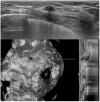Interobserver agreement on the interpretation of automated whole breast ultrasonography
- PMID: 25036754
- PMCID: PMC4176111
- DOI: 10.14366/usg.14015
Interobserver agreement on the interpretation of automated whole breast ultrasonography
Abstract
Purpose: The purpose of this study was to prospectively evaluate the interobserver agreement on lesion characterization and the final assessment of automated whole breast ultrasonography (ABUS) images.
Methods: Between March and August 2012, 172 women underwent bilateral ABUS before biopsy guided by handheld ultrasonography (HHUS) and mammography. A total of 206 breast lesions were confirmed histopathologically by biopsy. Three-dimensional volume data from ABUS scans were analyzed by two radiologists without the knowledge of HHUS results or patient clinical information. The two readers described the type, shape, orientation, margin, echogenicity, posterior acoustic features, and categorization of the final assessment of detected breast lesions. Kappa statistics were used to analyze the described characteristics of the breast lesions detected by both of the two readers.
Results: Of the 206 histopathologically confirmed lesions, reader 1 detected 166 lesions and reader 2 detected 150 lesions. A total of 145 lesions were detected by both readers using ABUS images. There was substantial agreement on shape (κ=0.707), and moderate agreement on type, margin, mass orientation, echogenicity, and posterior acoustic features (κ=0.592, 0.438, 0.472, 0.524, and 0.541, respectively). Breast Imaging Reporting and Data System final assessment values yielded a kappa value of 0.3971 when category subdivisions 4A, 4B, and 4C were included. With respect to the C2, C3, C4, and C5 categories, the interobserver agreement was moderate (κ=0.505).
Conclusion: ABUS is a promising diagnostic tool with a good interobserver agreement, comparable to that of HHUS.
Keywords: Breast; Observer variation; Ultrasonography.
Conflict of interest statement
No potential conflict of interest relevant to this article was reported.
Figures




References
-
- Bassett LW. Imaging of breast masses. Radiol Clin North Am. 2000;38:669–691. - PubMed
-
- Abdullah N, Mesurolle B, El-Khoury M, Kao E. Breast imaging reporting and data system lexicon for US: interobserver agreement for assessment of breast masses. Radiology. 2009;252:665–672. - PubMed
-
- Lazarus E, Mainiero MB, Schepps B, Koelliker SL, Livingston LS. BIRADS lexicon for US and mammography: interobserver variability and positive predictive value. Radiology. 2006;239:385–391. - PubMed
-
- Lee HJ, Kim EK, Kim MJ, Youk JH, Lee JY, Kang DR, et al. Observer variability of Breast Imaging Reporting and Data System (BI-RADS) for breast ultrasound. Eur J Radiol. 2008;65:293–298. - PubMed
LinkOut - more resources
Full Text Sources
Other Literature Sources
Miscellaneous

